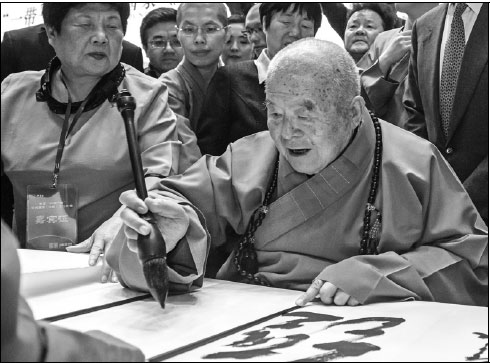Scholars spotlight Buddhism's role in bringing people closer
Updated: 2016-11-02 07:29
By Xing Yi(China Daily USA)
|
||||||||
Tang Dynasty (618-907) monk Xuanzang made overland trips to India along the ancient Silk Road in the 7th century to collect Buddhist sutras.
He later translated hundreds of the scriptures from Sanskrit to Chinese, contributing to the popularity of Buddhism in China and its proliferation in East Asia.
Containing around 260 characters, the Heart Sutra is a summary of the key doctrines of Mahayana Buddhism, one of the main existing branches of Buddhism. In Sanskrit, the title literally means the center of the "perfection of wisdom".
Xuanzang's version of this sutra is revered by Buddhist scholars and common people.
On Thursday, some 240 Buddhist monks and scholars from 30 countries and regions gathered in Nanjing, capital of East China's Jiangsu province, for the first Cultural Forum of the Heart Sutra. It was also held for countries that are looking with interest at China's Belt and Road Initiative.
The participants shared their views on the sutra and its implication on cultural exchanges.
Buddhism has deep roots and a long tradition in countries along the Silk Road, Xincheng, vice-president of the Buddhist Association of China, told the forum.
"We shall follow in the footsteps of master Xuanzang, using the wisdom of the Heart Sutra to resolve modern-day problems, and contribute to a world of peace and harmony," Xincheng said.
"Buddhism teaches humans the highest morality - to love people, have compassion, show kindness and tolerance," Prakrit Ranjan Barua, vice-president of the Bangladesh Bouddha Kristi Prachar Sangha, a Buddhist platform in Dhaka, said at the forum. "It's a religion, a spiritual science and a way of life."
After the opening ceremony, 30 monks and scholars together wrote the Heart Sutra on a long scroll, each writing one verse in his or her own language.
A point the sutra strongly makes is about the connects that exist among different things in the world.
"Through the overland and marine Silk Road, Buddhism connected Asia with Europe in the past," says Hsing Yun, 89, founder of the Fo Guang Shan Monastery in Taiwan.
This will help the ongoing revival of Chinese culture, he adds.
"I think the Belt and Road Initiative proposed by President Xi Jinping will make a great contribution to world stability and people's unity."
Naresh Man Bajracharya, vice chancellor of Lumbini Buddhist University in Nepal, recounted the many connections between Nepal and China, including a Nepali artist being invited by China to build the White Pagoda in Beijing during the Yuan Dynasty (1271-1368). It still stands today.
Maha Vihara, the chief high priest of Malaysia, talked about teaching Buddhism to the younger generations who are consumed by technology.
"We must create some new programs to reach out to young people without changing the basic teachings of the Buddha," he says.
The forum's attendees also visited the Niushoushan Temple in Nanjing, where a rare relic of the skull of the Buddha Sakyamuni has been enshrined since last year.
xingyi@chinadaily.com.cn
|
Hsing Yun, founder of the Fo Guang Shan Monastery in Taiwan, writes one verse of the Heart Sutra at the Nanjing forum.Guo Shasha / Provided To China Daily |
(China Daily USA 11/02/2016 page10)
- France to begin moving migrant minors from Calais
- China-Japan ties growing but unstable: Premier
- Analysts to watch Alibaba's cloud computing, mobile results
- UN Security Council hails election of new president in Lebanon
- Regular China-South Asia freight train launched
- Police swoop on Paris migrant camp after Calais Jungle clearout

 Robots draw people to China International Industry Fair
Robots draw people to China International Industry Fair
 German international Miroslav Klose retires
German international Miroslav Klose retires
 Top 10 most influential Japanese cartoons in China
Top 10 most influential Japanese cartoons in China
 Opera performer who takes her shows to villages
Opera performer who takes her shows to villages
 13 most appealing cars in China in 2016
13 most appealing cars in China in 2016
 Obamas host White House Halloween for children
Obamas host White House Halloween for children
 China Fashion Week: Liu Yong Exclusive
China Fashion Week: Liu Yong Exclusive
 Top 5 collaborating countries in Belt and Road Initiatives
Top 5 collaborating countries in Belt and Road Initiatives
Most Viewed
Economy on path of steady growth[1]|chinadaily.com.cn
Gay sex poses HIV threat for youth|Society|chinadaily.com.cn
Japan to release videos of Chinese activists|Asia-Pacific|chinadaily.com.cn
Gay sex blamed for rise in young students with HIV/AIDS|Society|chinadaily.com.cn
More young adults living with parents|Americas|chinadaily.com.cn
Magazine seeks Guangzhou expat families to tour Fujian[1]|chinadaily.com.cn
World's longest sightseeing escalator awaits you in Central China[4]|chinadaily.com.cn
Dai Ethnic Group[1]|chinadaily.com.cn
Minmetals unit offers sponge city solutions for rainfall usage|Business|chinadaily.com.cn
Licenses revoked in anti-porn campaign|Society|chinadaily.com.cn
Editor's Picks

|

|

|

|

|

|
Today's Top News
US election rhetoric unlikely to foreshadow future US-China relations
'Zero Hunger Run' held in Rome
Trump outlines anti-terror plan, proposing extreme vetting for immigrants
Phelps puts spotlight on cupping
US launches airstrikes against IS targets in Libya's Sirte
Ministry slams US-Korean THAAD deployment
Two police officers shot at protest in Dallas
Abe's blame game reveals his policies failing to get results
US Weekly

|

|










